Cabled Crochet Dog Sweater
Give your furry friend the gift of warmth and fashion with a cabled crochet dog sweater!
Crocheting a cabled dog sweater is a fun and rewarding project for any pet owner who enjoys crafting. Not only will it keep your dog warm during the colder months, but it will also give them a stylish, handmade garment that’s sure to turn heads at the doggie park.
You can find the crochet pattern for a dog sweater in this post below for free, or an ad-free print friendly version on Ravelry, or on Etsy (aff).
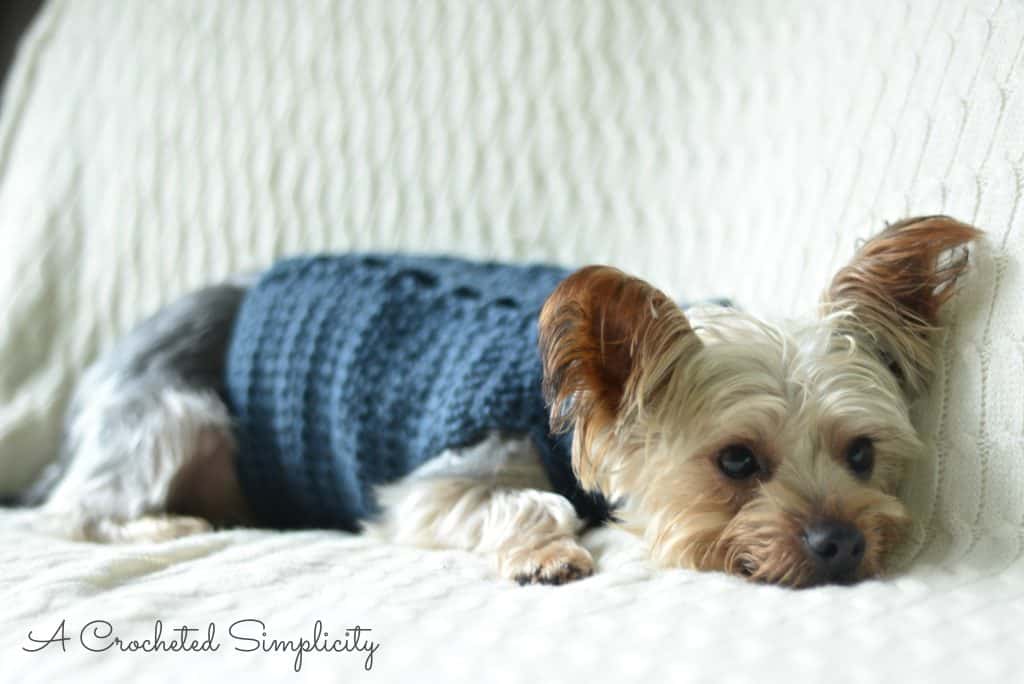
A cabled crochet dog sweater is a practical and crochet project that you and your dog will love. Whether you’re a seasoned crocheter or new to the craft, this project is a great way to challenge yourself with a fun and functional design. Plus, your dog will appreciate the extra warmth and style during those chilly walks.
And, if you love to crochet for charity, chilly dog sweaters are always welcomed by your local humane society.
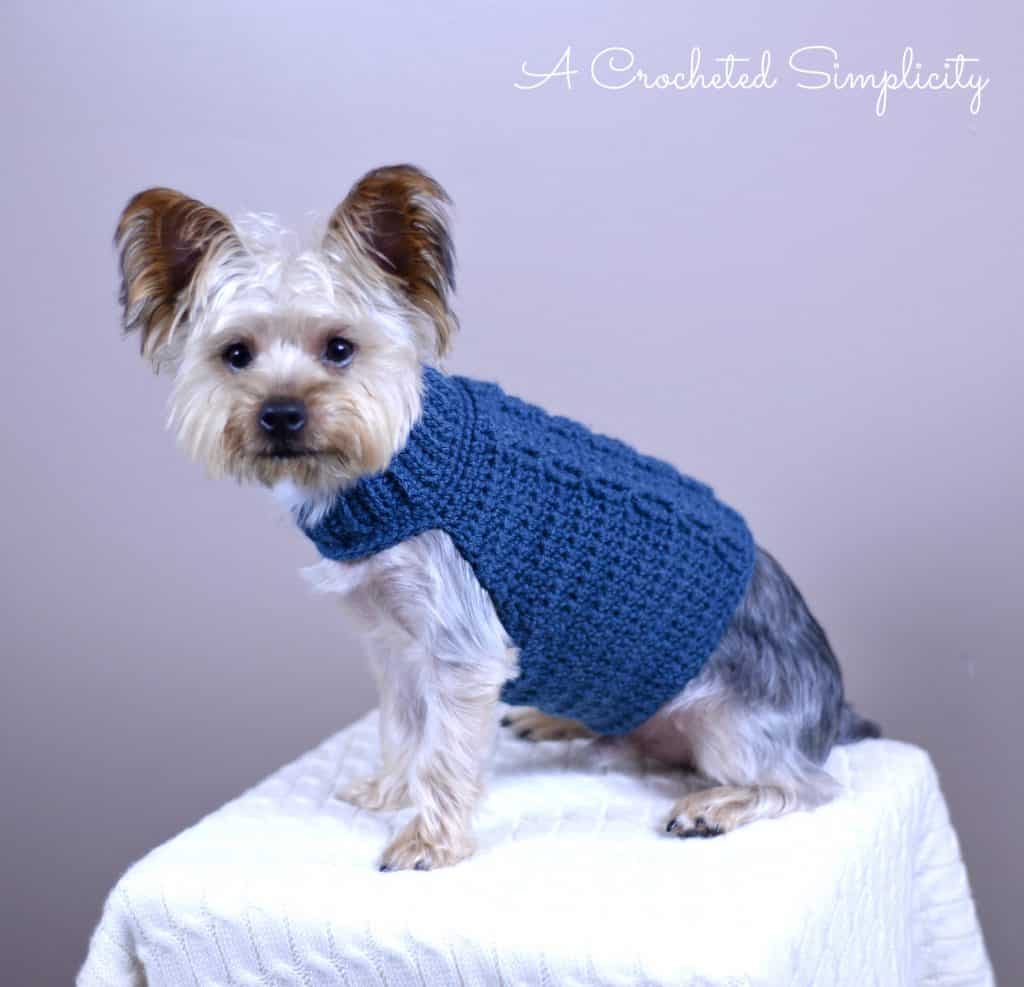
Why Crochet a Dog Sweater?
Whether you have a small dog that gets chilly in the winter or a larger breed that could benefit from a bit of extra warmth, crocheted dog sweaters provide a perfect solution. Plus, when you crochet your own, you can customize the size, color, and design to suit your dog’s personality. One popular design is the cabled dog sweater, which adds an elegant twist (literally!) to the basic dog sweater pattern.
Related: If you prefer an easy crochet dog sweater without crochet cables, make sure to take a peek at Chewy’s Dog Sweater.
Measuring Your Dog
To create the perfect fit, you’ll need to take a few key measurements of your dog:
- Neck circumference: Measure around the base of your dog’s neck.
- Chest circumference: Measure the widest part of your dog’s chest, just behind the front legs.
- Back length: Measure from the base of the neck to where you want the sweater to end on your dog’s back.
Having these measurements handy will ensure that your crocheted dog sweater fits snugly without being too tight or too loose.
How to Crochet a Dog Sweater
This one piece crochet dog sweater pattern is crocheted from the stretchy neck ribbing to the back end of the cabled sweater.
First, you’ll crochet the neck ribbing in rows and join the first and last rows to form a circle.
Then, you’ll crochet around the neck ribbing to edge it.
Next, you’ll begin the body of dog sweater by working rows partially around the neck. You’ll begin crocheting cables to add texture and interest to your dog sweater.
After crocheting a few rows of the dog sweater, you’ll add a chain to the end of a round and join that chain to the first stitch of the round to create a circle. This chain can be adjusted for a customized girth.
Lastly, the remainder of the body is worked in joined and turned rounds until the measurements listed in the pattern, or until your crochet dog sweater is the proper length to fit your pup.
Yarn
For this cabled crochet dog sweater, I chose Lion Brand Yarns Wool Ease, a worsted weight / 4 yarn. Wool Ease is an acrylic / wool blend yarn that is currently available in 31 gorgeous colors.
Each ball of a solid color of Wool Ease worsted yarn is 197 yards so if you’re making an extra small or small dog crochet sweater, this is a great one skein project! Even a large dog crochet sweater will use less than 2 balls of yarn.
With 31 colors to choose from, you’re sure to find the perfect color for your pet within this yarn line, but if not, there are several other worsted weight yarns that would make great substitutions. Lion Brand Wool Ease Recycled, Lion Brand Heartland, Lion Brand Pound of Love, Lion Brand Vanna’s Choice… just to name a few.
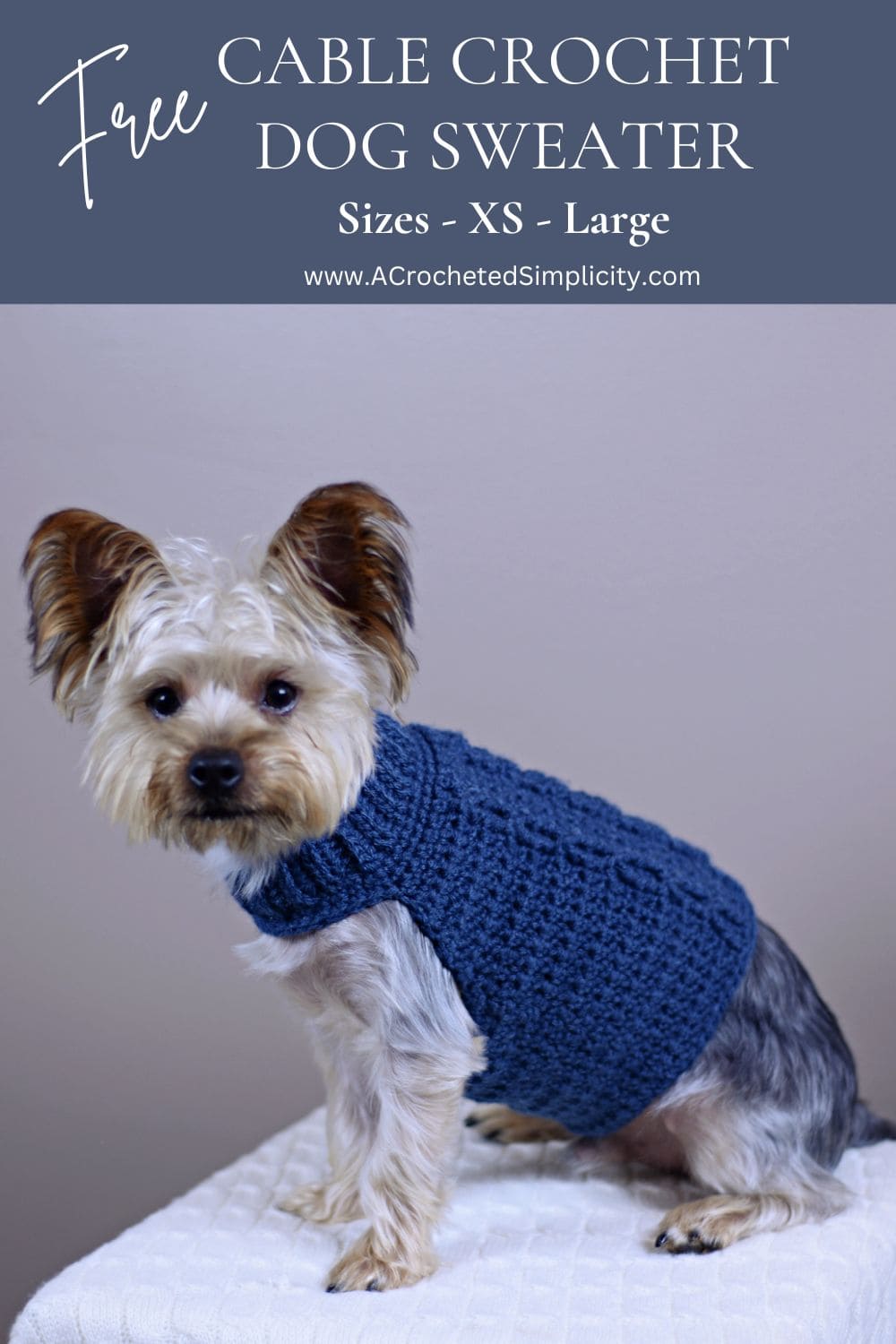
Cabled Crochet Dog Sweater Pattern
The cabled crochet dog sweater free pattern is below, but if you love to work offline, I’ve got a great option for you.
Purchase the ad-free, printable PDF, on Ravelry, and on Etsy (aff).
This post contains affiliate links.
Materials
- Yarn: Worsted Weight /4; Lion Brand Wool Ease was used for the mittens shown in the photos.
- Refer to the Size Chart below for exact yardage for the size you’re making.
- Crochet Hook: H/8/5.00mm, or size needed to obtain gauge (My favorite crochet hooks are the Clover Amour Hooks, I’ve never had an ache in my hand since switching)
- Scissors
- Yarn Needle
- Stitch Markers
Experience Level
- Intermediate
Sizes
- See Size & Yardage Chart below.
Gauge
- Neck Ribbing: 6 sts = 1.5″; 6.75 rows = 1.5″
- Body of Sweater in ext sc: 6.5 sts = 2″; 6.5 rows = 2″
Abbreviations (US Terms)
- ch(s): chain(s)
- st(s): stitch(es)
- sl st(s): slip stitch(es)
- sc: single crochet
- fpdc: front post double crochet
- bpdc: back post double crochet
- fptr: front post treble crochet
- ext sc: extended single crochet
- yo: yarn over
- RS: right side
- Rnd: round
- FLO: front loop only
- BLO: back loop only
- Six Strand Cable: see special stitches below
Special Stitches
- Extended Single Crochet (ext sc): Insert hook into stitch indicated, yo, pull up a loop, yo, pull thru 1 loop on hook, yo, pull thru remaining 2 loops on hook.
- Front Post Double Crochet (fpdc): Yo, insert hook from front to back to front around the post of the indicated stitch, yo, pull up a loop, yo, pull thru 2 loops, yo, pull thru remaining 2 loops.
- Back Post Double Crochet (bpdc): Yo, insert hook from back to front to back around the post of the designated stitch, yo, pull up a loop, yo, pull thru 2 loops, yo, pull thru remaining 2 loops.
- Front Post Treble Crochet (fptr): Yo 2 twice, insert hook from front to back to front around the post of the designated stitch, yo, pull up a loop, (yo, pull thru 2 loops) 3 times.
- Six Strand Cable: I have a photo and video tutorial showing how to work a six strand crochet cable that is similar to the wide cable in the center of this cabled crochet dog sweater. The taller stitches used during the cable twist are slightly different, but the technique is the same. If you’ve never worked cables before, you may find it helpful to see step-by-step and in motion in the video.
Pattern Notes
- Turning chains are not included in stitch count.
- The first stitch of each row is worked into the same stitch as the turning chain.
- I tend to crochet on the tighter side. You may find yourself needing to go down a hook size (or two) to properly meet gauge.
- Yarn Notes: Lion Brand Yarns Wool Ease in Denim was used for the sample shown, worsted weight yarn, (3 oz / 85 g / 197 yards / 180 m / 80% acrylic / 20% wool) per ball.
- Yardage: You will use 120 – 350 yards depending on the size cabled dog sweater you’re making. See the chart below for yardage required per size.
- Another comparable worsted weight yarn may be used as long as gauge is met.
- Changes for Sizes are written as follows: X-Small (Small, Medium, Large).
- Changes for Stitch Counts are as follows: (X-Small, Small, Medium, Large).
- Instructions are given within the pattern to customize both the girth and length of your sweater.
- Dog Sweater Construction Notes: You’ll begin by crocheting the neck ribbing in rows, then join the first and last row to form a circle. Then, you’ll crochet around the neck ribbing to edge it. Next, you’ll begin the body of dog sweater by working rows partially around the neck. After a few rounds, you’ll add a chain to the end of a round and join to the first stitch to create a circle. Lastly, the remainder of the body is worked in joined and turned rounds.
Crochet Dog Sweater Size Chart & Yardage Requirements
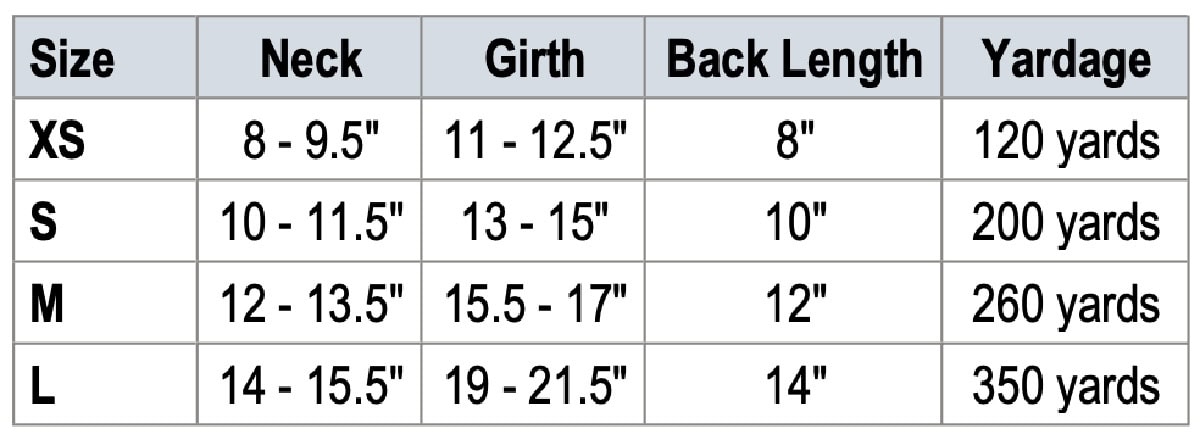
Crochet Dog Sweater Pattern
Changes for Sizes Written as Follows: X-Small (Small, Medium, Large)
Neck Ribbing
Row 1 (RS): With yarn & a 5.00mm crochet hook, ch 7, working into the back hump of the chain, sc into the 2nd ch from your hook and in each ch across. Turn. (6 sts)
Row 2: Ch 1, BLO sl st in each st across. Turn. (6 sts)
Row 3: Ch 1, BLO sc in each st across. Turn. (6 sts)
Rows 4 – 37 (43, 49, 55): Rep Rows 2 – 3. (6 sts)
Row 38 (44, 50, 56): With the RS facing out, bring the 1st row to meet the last row. Position your working yarn so that it’s on the inside of the neck. Ch 1, (Insert your hook from front to back into the FLO of the 1st st of Row 1, insert your hook from back to front into the BLO of the 1st st of the last row, yo, pull thru all loops to complete sl st) repeat across. (6 sts)
Do not fasten off. Continue on to Neck Edging.
Neck Edging
Rnd 1 (RS): Ch 1, sc into the side of each row around the neck. Join with a sl st to 1st st. (38, 44, 50, 56 sts)
Rnds 2 (2 – 3) (2 – 3) (2 – 4): Ch 1, sc in each st around. Join. (38, 44, 50, 56 sts)
Do not fasten off. Continue on to the Body of Sweater.
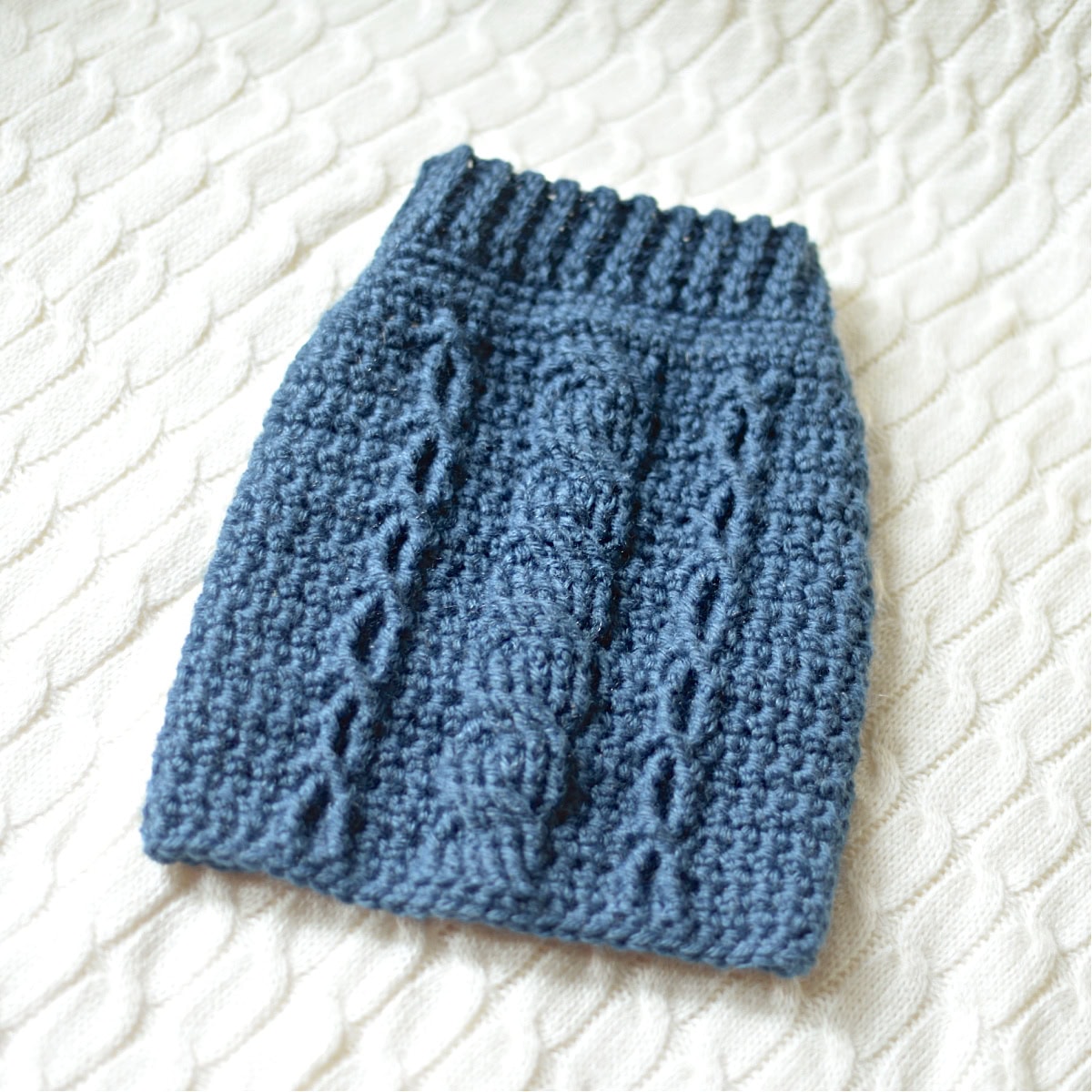
Body of Sweater
Row 1 (RS): Ch 1, 2 ext sc in the first st, ext sc in each of the next 20 (26, 32, 38) sts, 2 ext sc in the next st. Turn. (24, 30, 36, 42 sts) *Note: You will not be working all the way around the neck. You will have unworked stitches from the neck edging.
Row 2: Ch 1, 2 ext sc in the first st, ext sc in each of the next 2 (5, 8, 11) sts, bpdc around the next st, ext sc in the next st, bpdc around the next st, ext sc in each of the next 3 sts, bpdc around each of the next 6 sts, ext sc in each of the next 3 sts, bpdc around the next st, ext sc in the next st, bpdc around the next st, ext sc in each of the next 2 (5, 8, 11) sts, 2 ext sc in the last st. Turn. (26, 32, 38, 44 sts)
Row 3: Ch 1, 2 ext sc in the first st, ext sc in each of the next 3 (6, 9, 12) sts, skip each of the next 2 sts, fptr around the next post st, ext sc in the skipped ext sc, fptr around the skipped post st, ext sc in each of the next 3 sts, skip each of the next 3 post sts, fptr around each of the next 3 post sts, working in front of the fptr just made, fptr around each of the 3 skipped post sts, ext sc in each of the next 3 sts, skip each of the next 2 sts, fptr around the next post st, ext sc in the skipped ext sc, fptr around the skipped post st, ext sc in each of the next 3 (6, 9, 12) sts, 2 ext sc in the last st. Turn. (28, 34, 40, 46 sts)
Row 4: Ch 1, 2 ext sc in the first st, ext sc in each of the next 4 (7, 10, 13) sts, bpdc around the next post st, ext sc in the next st, bpdc around the next post st, ext sc ineach of the next 3 sts, bpdc around each of the next 6 post sts, ext sc in each of the next 3 sts, bpdc around the next post st, ext sc in the next st, bpdc around the next post st, ext sc in each of the next 4 (7, 10, 13) sts, 2 ext sc in the last st. Turn. (30, 36, 42, 48 sts)
Row 5: Ch 1, ext sc in each of the next 6 (9, 12, 15) sts, fpdc around the next post st, ext sc in the next st, fpdc around the next post st, ext sc in each of the next 3 sts, fpdc around each of the next 6 post sts, ext sc in each of the next 3 sts, fpdc around the next post st, ext sc in the next st, fpdc around the next post st, ext sc in each of the last 6 (9, 12, 15) sts. Turn. (30, 36, 42, 48 sts)
Row 6: Ch 1, ext sc in each of the next 6 (9, 12, 15) sts, bpdc around the next post st, ext sc in the next st, bpdc around the next post st, ext sc in each of the next 3 sts, bpdc around each of the next 6 post sts, ext sc in each of the next 3 sts, bpdc around the next post st, ext sc In the next st, bpdc around the next post st, ext sc in each of the last 6 (9, 12, 15) sts. Turn. (30, 36, 42, 48 sts)
Adjustments for Girth: If you need to adjust the sweater girth, you can do so at the end of Round 7 where you chain X. Simply add or subtract chains as needed to adjust the girth.
Rnd 7: Ch 1, ext sc in each of the next 6 (9, 12, 15) sts, skip each of the next 2 sts, fptr around the next post st, ext sc in the skipped ext sc, fptr around the skipped post st, ext sc in each of the next 3 sts, skip each of the next 3 post sts, fptr around each of the next 3 post sts, working in front of the fptr just made, fptr around each of the 3 skipped post sts, ext sc in each of the next 3 sts, skip each of the next 2 sts, fptr around the next post st, ext sc in the skipped ext sc, fptr around the skipped post st, ext sc in each of the last 6 (9, 12, 15) sts, loosely ch 11 (12, 13, 22). Join with a sl st to the 1st st of the round. Turn. (41, 48, 55, 70 sts)
Joined & Turned Rounds: The remainder of this crochet dog sweater is crocheted in joined and turned rounds.
Rnd 8: Ch 1, ext sc in each ch, ext sc in each st to the next post st, bpdc around the next post st, ext sc in the next st, bpdc around the next post st, ext sc in each of the next 3 sts, bpdc around each of the next 6 post sts, ext sc in each of the next 3 sts, bpdc around the next post st, ext sc in the next st, bpdc around the next post st, ext sc in each remaining st around. Join. Turn. (41, 48, 55, 70 sts)
Rnd 9: Ch 1, ext sc in each st to the next post st, fpdc around the next post st, ext sc in the next st, fpdc around the next post st, ext sc in each of the next 3 sts, fpdc around each of the next 6 post sts, ext sc in each of the next 3 sts, fpdc around the next post st, ext sc in the next st, fpdc around the next post st, ext sc in each remaining st around. Join. Turn. (41, 48, 55, 70 sts)
Rnd 10: Ch 1, ext sc in each st to the next post st, bpdc around the next post st, ext sc in the next st, bpdc around the next post st, ext sc in each of the next 3 sts, bpdc around each of the next 6 post sts, ext sc in each of the next 3 sts, bpdc around the next post st, ext sc in the next st, bpdc around the next post st, ext sc in each remaining st around. Join. Turn. (41, 48, 55, 70 sts)
Rnd 11: Ch 1, ext sc in each st to the next post st, skip each of the next 2 sts, fptr around the next post st, ext sc in the skipped ext sc, fptr around the skipped post st, ext sc in each of the next 3 sts, skip each of the next 3 post sts, fptr around each of the next 3 post sts, working in front of the fptr just made, fptr around each of the 3 skipped post sts, ext sc in each of the next 3 sts, skip each of the next 2 sts, fptr around the next post st, ext sc in the skipped ext sc, fptr around the skipped post st, ext sc in each remaining st around. Join. Turn. (41, 48, 55, 70 sts)
Rnd 12: Ch 1, ext sc in each st to the next post st, bpdc around the next post st, ext sc in the next st, bpdc around the next post st, ext sc in each of the next 3 sts, bpdc around each of the next 6 post sts, ext sc in each of the next 3 sts, bpdc around the next post st, ext sc in the next st, bpdc around the next post st, ext sc in each remaining st around. Join. Turn. (41, 48, 55, 70 sts)
Repeat Rounds 9 – 12, ending with an even numbered round, until your crochet dog sweater measures 8” (10”, 12”, 14”) including the neck ribbing.
Final Round: Ch 1, sc in each st around. Join. (41, 48, 55, 70 sts)
Fasten off. Weave in ends.
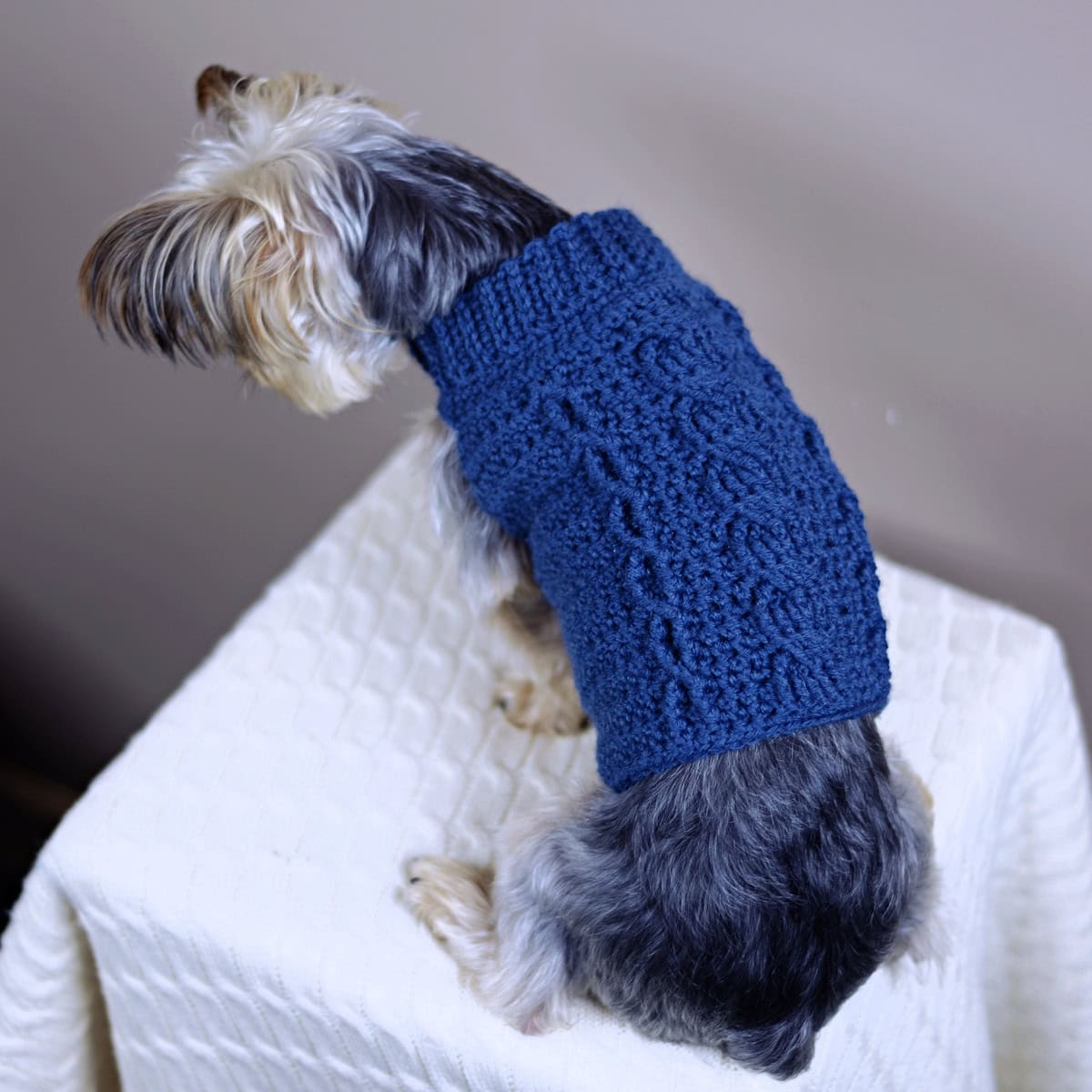
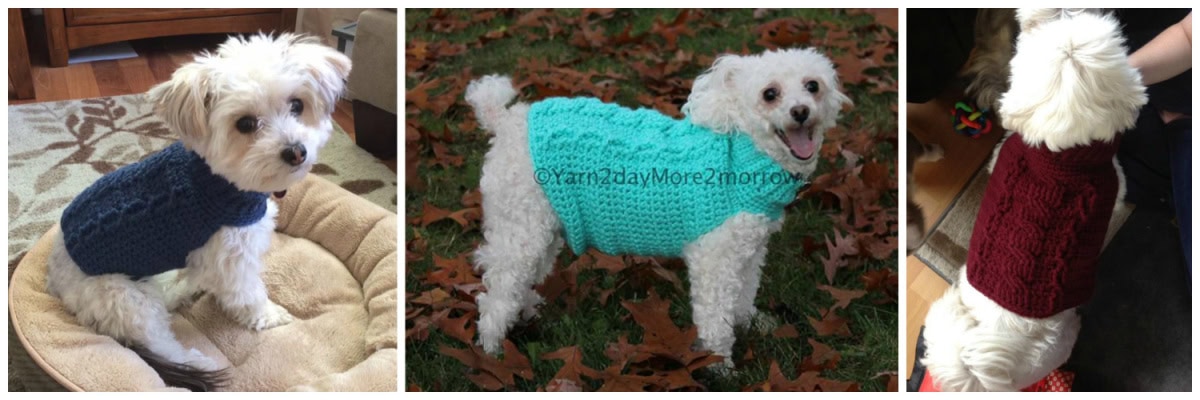
I hope you’ve enjoyed making your Cabled Dog Sweaters and that they’re enjoyed by lots of local dogs in need. <3 Please share a photo of your finished sweaters with me in my Facebook group: A Crocheted Simplicity Crochet Community Group.
I Made It! Now What?
Pin this post! Save this free crochet mittens pattern to your Pinterest boards so that you can come back and make it again.
Leave a comment below: We love to hear your feedback.
Share Your Finished Projects on Facebook or Instagram: I love to see your finished projects! Share with us on social media and tag me @acrochetedsimplicity or use the hashtag #ACrochetedSimplicity so I can find your posts.
Join us in the Facebook Community Group!
Come share your finished projects with us in the A Crocheted Simplicity Crochet Community Group on Facebook. Join us for fun community events such as crochet alongs, join in on crochet conversations, ask questions, get advice, and share your love for crochet!
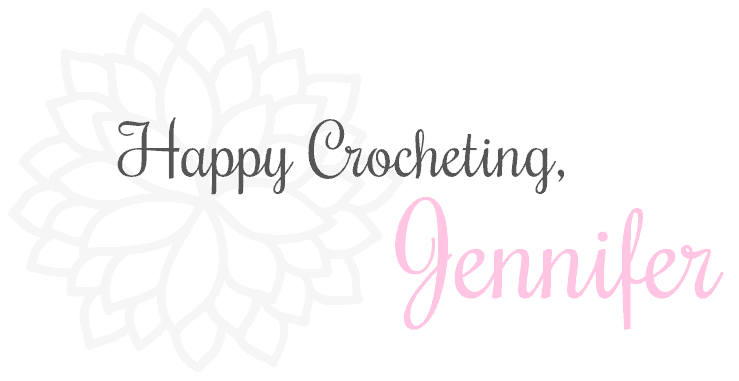
More Free Patterns with Crochet Cables
If you love cables and are looking for another crochet cables pattern, we have several more free crochet patterns we think you’ll love! We have larger projects such as cable sweaters, cardigans, and blankets to smaller crochet projects such as beanies, cowls, and wine cozies.

Just made this for my Himalayan kitty.. She is about to get groomed where she will be shaved down to practically no fur.. Need something to keep her nice and warm in the mean time. Thank you!
You’re welcome! 🙂
This is really crappy picture of the sweater…. Need more of the sweater and less of your dog’s FACE!
Hi Rita,
If you read through the pattern post, you will see that there are flat lay photos that show the entire sweater.
Happy Crocheting,
Jennifer
Row 3 of the body totally lost me. I’m an advanced beginner, but I’m confused with skipping, the fptr in skipped ext sc. Please help.
Hi Brenda~ This part is the small cables on each side of the larger cable. It is worked over 3 sts total. Think of them as sts 1, 2, 3…. Skip stitches 1 & 2, work a Fptr around st #3, then work a ext sc in st #2 (the one in the middle), then work a FPtr around st #1 (this makes the cross of the cable). A good rule to remember here is that all of your post sts will be worked around post sts. I hope this helps!
Jennifer
When you measure the sweater at the end, does it include the collar? Or do you measure from where the body of the sweater starts. Thank you…. Lovely pattern x
Hi Julie, The measurement included the collar.
What size was on the dog in the pictures?
Hi Amanda,
He wears a size small.
Jennifer
Hi. I want to make this sweater, but I don’t see how to make the leg openings? Does it have opening for both legs, or is it just split somehow? I hope it’s not a dum question, I’m totally blind so I can’t see the pictures or I’d probably know the answer.
Hi Melanie.
After you work the neck & neck edging, you begin the body of the sweater. Take a peak at the stitch counts here as you don’t work all the way around the neck. You’ll work in rows that are shorter than the neck circumference. This is where the hole for the legs is created. There aren’t 2 leg openings, just one wider one as I prefer this style…easier to get on and off the pups. 🙂
I hope this helps!
Jennifer
Can’t wait to give this a try for my grandson’s little dog & my kitties.
I was getting SO frustrated with this pattern… I was convinced the instructions had mixed up back posts and front posts, and I was incredibly annoyed at having to reverse it.
…Well, guess who then realized that the sweater had gotten turned inside out in the middle of making the body? 😂
Once I figured out my error and unraveled all those mistaken rows, this pattern was easy to follow and looked great! I’m not quite finished yet because my dog is some sort of short haired border collie mix with probably a dash of whippet, so I’m having to decrease a little as I go to make it fit his weird barrel shape. Still, I’ve been trying it on him as I go, and he looks very dapper so far!
Oh noooo!!!! That’s a big bummer! But I’m so glad you got it all figured out. 🙂
Happy Crocheting,
Jennifer